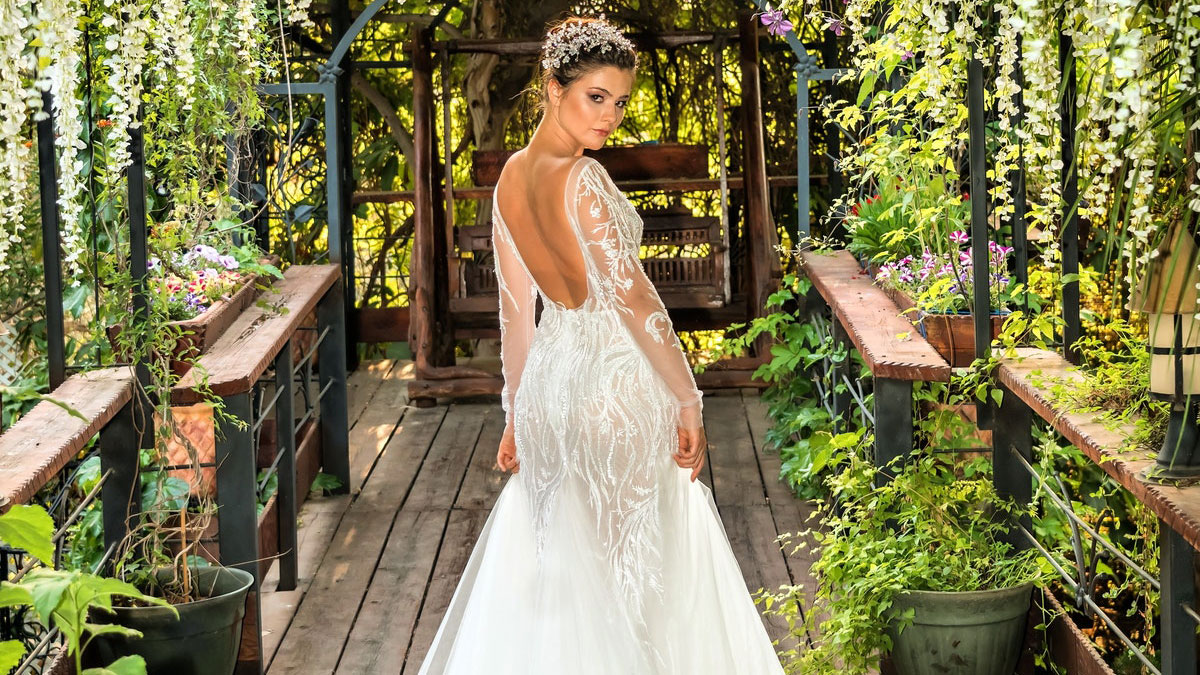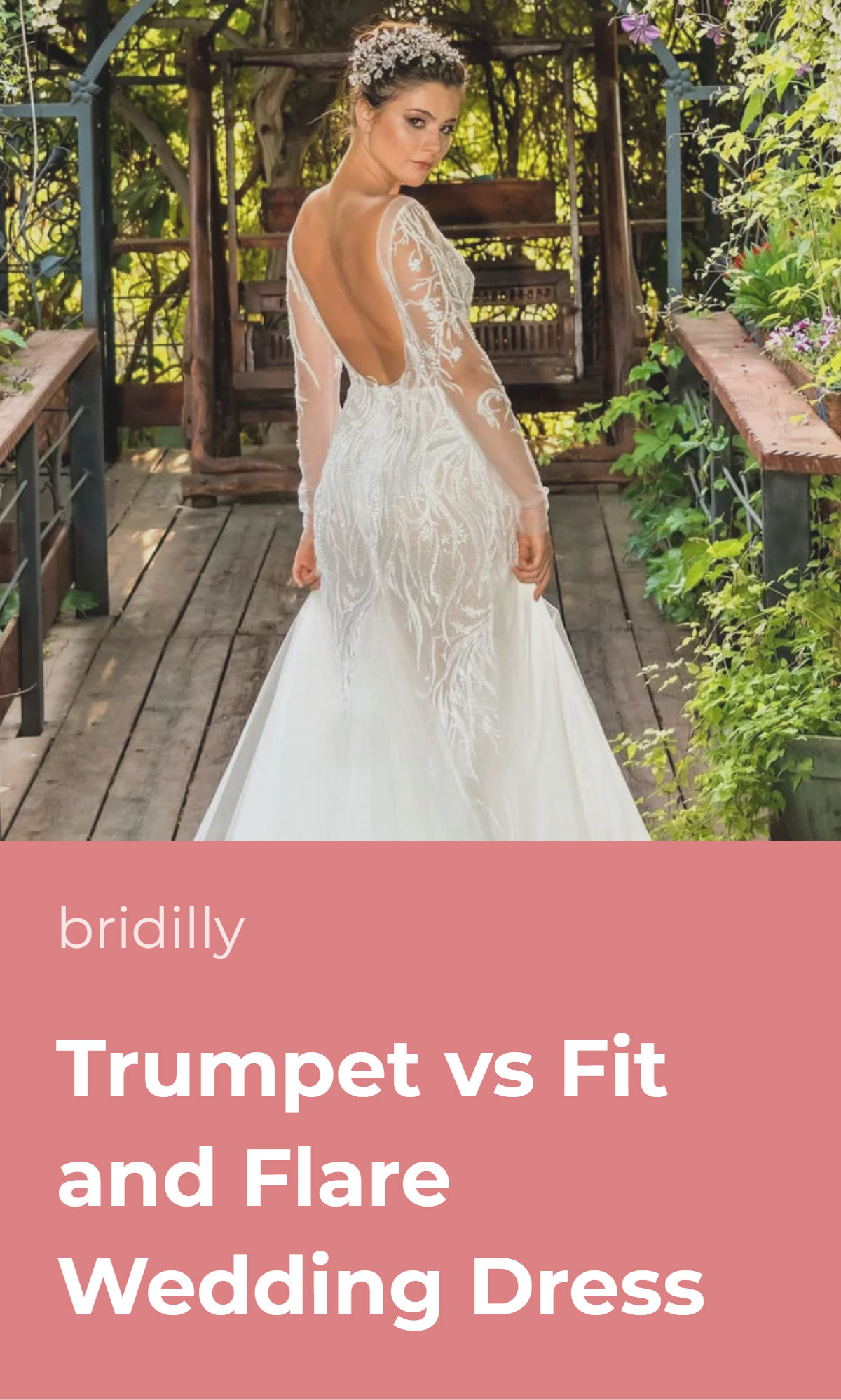The difference between the trumpet vs. fit and flare wedding dress styles confuses many brides. Sometimes, these terms are even used interchangeably.
However, this isn’t quite right, even though every trumpet dress is a variation of the fit and flare cut.
Most bridal stylists mean a very specific dress cut when they say “fit and flare.” And while the fit and flare and trumpet styles have more similarities than differences, these minor distinctions can significantly impact your look.
Choosing the right wedding dress silhouette is vital not solely because of the looks. The dress style also affects your comfort. If you plan to hit the dancefloor, that’s a point to consider.
Most importantly, you should feel confident in your wedding dress. Pick a style that suits your personality, body type, and wedding style.
Table of Contents [show]
Where the Flare Starts
Both trumpet and fit and flare wedding dress silhouettes have a fitted bodice, often with a corset. Both hug the hips, enhancing natural curves, but they aren’t the same.
Technically, a trumpet wedding dress is a fit and flare cut variation. The name says it all – fit and flare gowns are fitted at the top and flare at the bottom.
Some people use the term fit and flare to describe any dress that flares at the bottom, including trumpet and mermaid cuts. However, most designers consider fit and flare a distinct dress style that differs from trumpet and mermaid.
The core difference between the trumpet and fit and flare wedding dress styles is the flare, specifically where the flare starts. In trumpet dresses, the skirt’s flare starts at mid-thigh.
The wedding dress style where the flare begins at the knees is called the mermaid cut.
It’s the least comfortable of all flared wedding dress styles. Meanwhile, in fit and flare wedding dresses, the flare starts higher, at the hip area.
In some designs, the flare may start right at the top of the hips, and in others, it begins at the upper thigh.
The fit and flare style sometimes resembles an A-line silhouette with a dropped waist and is called a modified A-line. However, some bridal salon stylists may get confused by this term, as fit and flare is a more common name.
The skirt in trumpet wedding dress style is always long, while fit and flare dresses may have knee-length or tea-length skirts.
The Flare Size
The fit and flare wedding dress style has a gradually flaring skirt, creating a natural, harmonious silhouette.
The upper skirt part isn’t too restrictive, and there shouldn’t be an apparent transition between the fitted and flared skirt parts.
On the other hand, trumpet wedding dresses may have a gradually flaring skirt or a tight upper skirt part with a dramatic, oversized flare. Trumpet gowns often have long trains, sometimes reaching three meters.
So, if you see a dress with an extra-voluminous, layered skirt contrasting with a tight waist and hip area, it’s most likely a trumpet or mermaid dress. Fit and flare wedding dresses always have a balanced silhouette.
Fit and flare dresses can have long trains, but the skirt hem usually isn’t as wide as it can be in a trumpet silhouette.
Comfort
Trumpet wedding gowns aren’t the most comfortable choice for dancing, although they’re undoubtedly better than tight mermaid dresses and puffy ball gowns.
A trumpet wedding dress’s comfort largely depends on the flare size. The defining characteristic of a trumpet style is where the flare starts, but the size and shape can differ.
A trumpet wedding dress with a gradual, moderately-sized flare from flowy fabric is an excellent choice for brides who don’t want to compromise comfort. It will allow you to take the stairs and dance without any issue.
On the other hand, a trumpet wedding gown with an oversized, layered flare and an extra-tight hip area may feel a bit restrictive, and the voluminous skirt can create space between partners during dancing.
Thankfully, you can learn to dance in virtually any wedding dress, but a trumpet dress with dramatic flaring will require more practice.
Fit and flare wedding dresses are more dance-friendly. This style doesn’t restrict movement because the flare starts at the hips, and the skirt is typically flowy and moderately wide. You can easily walk around and take the stairs.
Of course, the skirt isn’t the only factor affecting a wedding dress’s comfort. Dresses with a long train will require plenty of practice regardless of the silhouette.
Both trumpet and fit and flare wedding dress styles often feature corseted bodices as they draw all attention to the waist area. The corset helps to make the silhouette more attractive, but it can be difficult to breathe in.
If your dress has a corset, make sure one of your bridesmaids or your mom can help you loosen the corset after the ceremony.
Style
Both fit and flare and trumpet wedding dress styles are classy, elegant, and sexy simultaneously. Even if you opt for a long-sleeve, high-neck gown from opaque fabric, these silhouettes will look seductive.
Fit and flare and trumpet wedding gowns come with any neckline and sleeve style, from any fabric, and in any color.
However, fit and flare wedding dresses typically look more traditional and modest than trumpet gowns due to the moderate flare.
Of course, a trumpet gown can have a corseted strapless bodice, an open back, a long train, or other details that make it extra dramatic. But the gradual flare perfectly balances such elements.
Trumpet wedding dresses always look more extravagant than fit and flare gowns, regardless of the neckline and sleeves, due to more prominent flare.
This style is perfect for brides who love to draw attention and want a bridal attire everyone will remember for long.
However, it’s important not to go overboard with sexy details, as plunging neckline and open back in combination with a tight upper skirt and dramatic flare may look excessive.
Since both trumpet and fit and flare wedding dress’ silhouettes give a sophisticated feel, they look beyond gorgeous in elegant venues. These silhouettes can fit any wedding style, from bohemian to regal, depending on the design.
A common misconception is that trumpet and fit and flare wedding dress styles don’t fit rustic weddings. The truth is that it’s all about the details.
Of course, a trumpet dress embossed with crystals with a strapless corset bodice will look odd in a barn or farmhouse.
However, if you choose flowy natural fabrics with minimalist embellishments and opt for a modest upper part, a trumpet dress will beautifully fit a rustic setting.
For example, a fit and flare dress with long balloon sleeves and boat neckline from ivory lace is perfect for a bohemian bride, while an embellished stark white trumpet dress with an illusion neckline and puffy organza skirt gives off a regal vibe.
Accessories, hairstyle, and makeup can help you fit the desired dress silhouette in any wedding style and setting, so there’s no need to compromise your preferences.
Body Type
The perfect wedding dress should enhance your figure’s best parts and conceal imperfections, so considering your body type when choosing the silhouette is vital.
Trumpet and fit and flare wedding dress styles are similar in the sense that they both enhance natural curves, hugging hips and defining the waist.
These cuts look the best on brides with hourglass and pear body types characterized by a narrow waist.
Trumpet and fit and flare dresses aren’t the best choice for brides concerned about their tummy area due to the fitted bodice. You don’t want to think about maintaining a slim profile instead of enjoying the day.
Note that this isn’t about the size but rather about confidence. Curvy brides look equally gorgeous in fit and flare and trumpet gowns as slender brides.
The bottom line is that trumpet and fit and flare wedding dresses require confidence and a well-defined waist. Meanwhile, trumpet also showcases the hips and thighs, while fit and flare silhouette is more forgiving for that area.
The trumpet dress silhouette isn’t the best fit for brides with an inverted triangle body type, as the fitted skirt will only enhance the shoulder width. A classic A-line or ball gown are much better options.
However, if a fit and flare gown’s flare starts at the mid-hip, it can beautifully fit a bride with an inverted triangle body type, balancing the upper body part.
Brides wishing to conceal their hips should choose fit and flare gowns with skirts flaring from the upper hip part. On the opposite, those wishing to showcase the hip curves should consider trumpet gowns.
Naturally, how well a dress will fit your body type also depends on the neckline and sleeves. Even if you have broad shoulders but admire the trumpet silhouette, the right sleeves can help to balance the proportions.
Trumpet and fit and flare wedding gowns are also perfect for petite brides, as these silhouettes visually elongate legs. Tall brides who don’t want to appear even taller may consider wearing these silhouettes with flat shoes.



















No Comments Add one
Leave a Comment